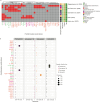From network biology to immunity: potential longitudinal biomarkers for targeting the network topology of the HIV reservoir
- PMID: 40804634
- PMCID: PMC12351972
- DOI: 10.1186/s12967-025-06919-z
From network biology to immunity: potential longitudinal biomarkers for targeting the network topology of the HIV reservoir
Abstract
In the "omics" era, studies often utilize large-scale datasets, eliciting the overall functional machinery of a network's organization. In this context, determining how to read the enormous number of interactions in a network is imperative to comprehend its functional organization. Topology is the principal attribute of any network; as such, topological properties help to elucidate the roles of entities and represent a network's behavior. In this review, I showcase the foundational concepts involved in graph theory, which form the basis of network biology, and exemplify the application of this conceptual framework to bridge the connection between the task-evoked functional genome network of the HIV reservoir. Furthermore, I point out potential longitudinal biomarkers identified using network-based analysis and systematically compare them with other potential biomarkers identified based on experimental research with longitudinal clinical samples.
Keywords: Biological networks; Deep learning; Elite controllers; Graph theory; HIV reservoir; Immunologic signatures; Longitudinal biomarkers; Network analysis; Network topology.
© 2025. The Author(s).
Conflict of interest statement
Declarations. Ethics approval and consent to participate: Not applicable. Consent for publication: Not applicable. Competing interests: The author declares that they have no competing interests.
Figures





Similar articles
-
Prescription of Controlled Substances: Benefits and Risks.2025 Jul 6. In: StatPearls [Internet]. Treasure Island (FL): StatPearls Publishing; 2025 Jan–. 2025 Jul 6. In: StatPearls [Internet]. Treasure Island (FL): StatPearls Publishing; 2025 Jan–. PMID: 30726003 Free Books & Documents.
-
Short-Term Memory Impairment.2024 Jun 8. In: StatPearls [Internet]. Treasure Island (FL): StatPearls Publishing; 2025 Jan–. 2024 Jun 8. In: StatPearls [Internet]. Treasure Island (FL): StatPearls Publishing; 2025 Jan–. PMID: 31424720 Free Books & Documents.
-
Antidepressants for depression in adults with HIV infection.Cochrane Database Syst Rev. 2018 Jan 22;1(1):CD008525. doi: 10.1002/14651858.CD008525.pub3. Cochrane Database Syst Rev. 2018. PMID: 29355886 Free PMC article.
-
Optimizing hybrid network topologies in communication networks through irregularity strength.Sci Rep. 2025 Aug 11;15(1):29330. doi: 10.1038/s41598-025-05631-8. Sci Rep. 2025. PMID: 40789847 Free PMC article.
-
Systemic pharmacological treatments for chronic plaque psoriasis: a network meta-analysis.Cochrane Database Syst Rev. 2021 Apr 19;4(4):CD011535. doi: 10.1002/14651858.CD011535.pub4. Cochrane Database Syst Rev. 2021. Update in: Cochrane Database Syst Rev. 2022 May 23;5:CD011535. doi: 10.1002/14651858.CD011535.pub5. PMID: 33871055 Free PMC article. Updated.
References
Publication types
MeSH terms
Substances
Grants and funding
LinkOut - more resources
Full Text Sources
Medical

